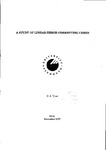A STUDY OF LINEAR ERROR CORRECTING CODES
| dc.contributor.author | TJHAI, CEN JUNG | |
| dc.contributor.other | School of Engineering, Computing and Mathematics | en_US |
| dc.date.accessioned | 2013-09-10T10:11:38Z | |
| dc.date.available | 2013-09-10T10:11:38Z | |
| dc.date.issued | 2007 | |
| dc.identifier | NOT AVAILABLE | en_US |
| dc.identifier.uri | http://hdl.handle.net/10026.1/1624 | |
| dc.description.abstract |
Since Shannon's ground-breaking work in 1948, there have been two main development streams of channel coding in approaching the limit of communication channels, namely classical coding theory which aims at designing codes with large minimum Hamming distance and probabilistic coding which places the emphasis on low complexity probabilistic decoding using long codes built from simple constituent codes. This work presents some further investigations in these two channel coding development streams. Low-density parity-check (LDPC) codes form a class of capacity-approaching codes with sparse parity-check matrix and low-complexity decoder Two novel methods of constructing algebraic binary LDPC codes are presented. These methods are based on the theory of cyclotomic cosets, idempotents and Mattson-Solomon polynomials, and are complementary to each other. The two methods generate in addition to some new cyclic iteratively decodable codes, the well-known Euclidean and projective geometry codes. Their extension to non binary fields is shown to be straightforward. These algebraic cyclic LDPC codes, for short block lengths, converge considerably well under iterative decoding. It is also shown that for some of these codes, maximum likelihood performance may be achieved by a modified belief propagation decoder which uses a different subset of 7^ codewords of the dual code for each iteration. Following a property of the revolving-door combination generator, multi-threaded minimum Hamming distance computation algorithms are developed. Using these algorithms, the previously unknown, minimum Hamming distance of the quadratic residue code for prime 199 has been evaluated. In addition, the highest minimum Hamming distance attainable by all binary cyclic codes of odd lengths from 129 to 189 has been determined, and as many as 901 new binary linear codes which have higher minimum Hamming distance than the previously considered best known linear code have been found. It is shown that by exploiting the structure of circulant matrices, the number of codewords required, to compute the minimum Hamming distance and the number of codewords of a given Hamming weight of binary double-circulant codes based on primes, may be reduced. A means of independently verifying the exhaustively computed number of codewords of a given Hamming weight of these double-circulant codes is developed and in coiyunction with this, it is proved that some published results are incorrect and the correct weight spectra are presented. Moreover, it is shown that it is possible to estimate the minimum Hamming distance of this family of prime-based double-circulant codes. It is shown that linear codes may be efficiently decoded using the incremental correlation Dorsch algorithm. By extending this algorithm, a list decoder is derived and a novel, CRC-less error detection mechanism that offers much better throughput and performance than the conventional ORG scheme is described. Using the same method it is shown that the performance of conventional CRC scheme may be considerably enhanced. Error detection is an integral part of an incremental redundancy communications system and it is shown that sequences of good error correction codes, suitable for use in incremental redundancy communications systems may be obtained using the Constructions X and XX. Examples are given and their performances presented in comparison to conventional CRC schemes. | en_US |
| dc.language.iso | en | en_US |
| dc.publisher | University of Plymouth | en_US |
| dc.title | A STUDY OF LINEAR ERROR CORRECTING CODES | en_US |
| dc.type | Thesis | |
| plymouth.version | Full version | en_US |
| dc.identifier.doi | http://dx.doi.org/10.24382/3314 |
Files in this item
This item appears in the following Collection(s)
-
01 Research Theses Main Collection
Research Theses Main


